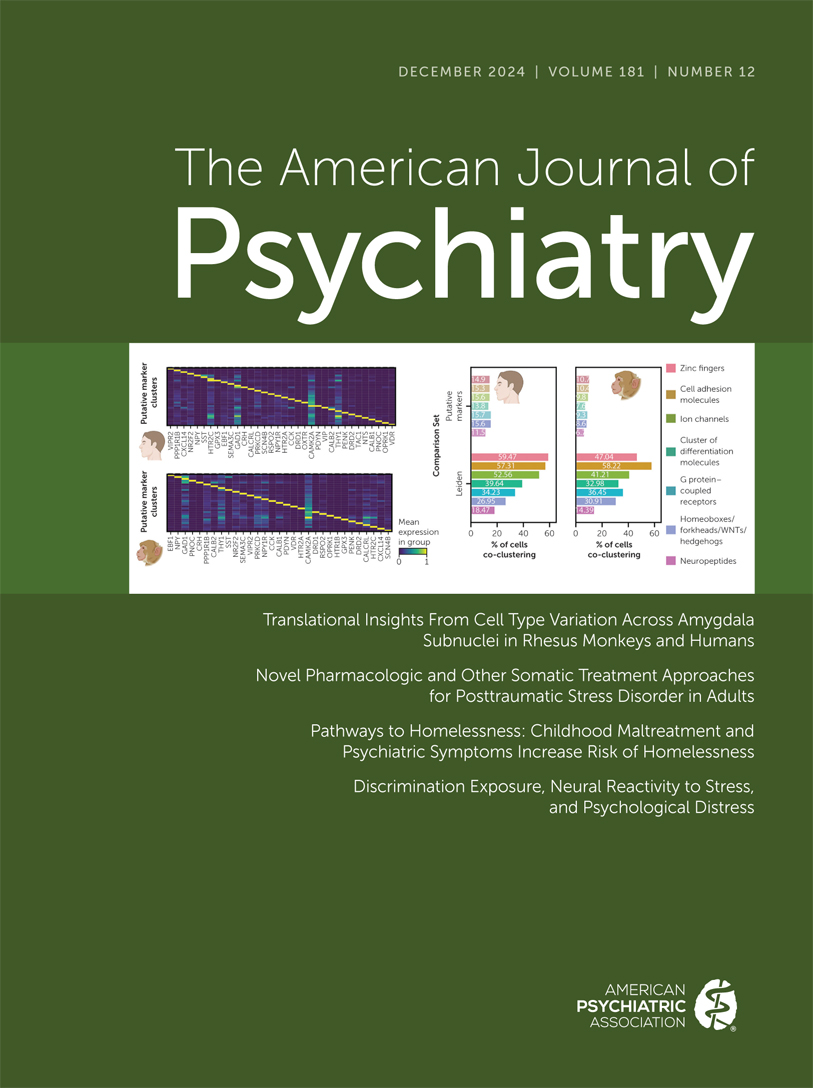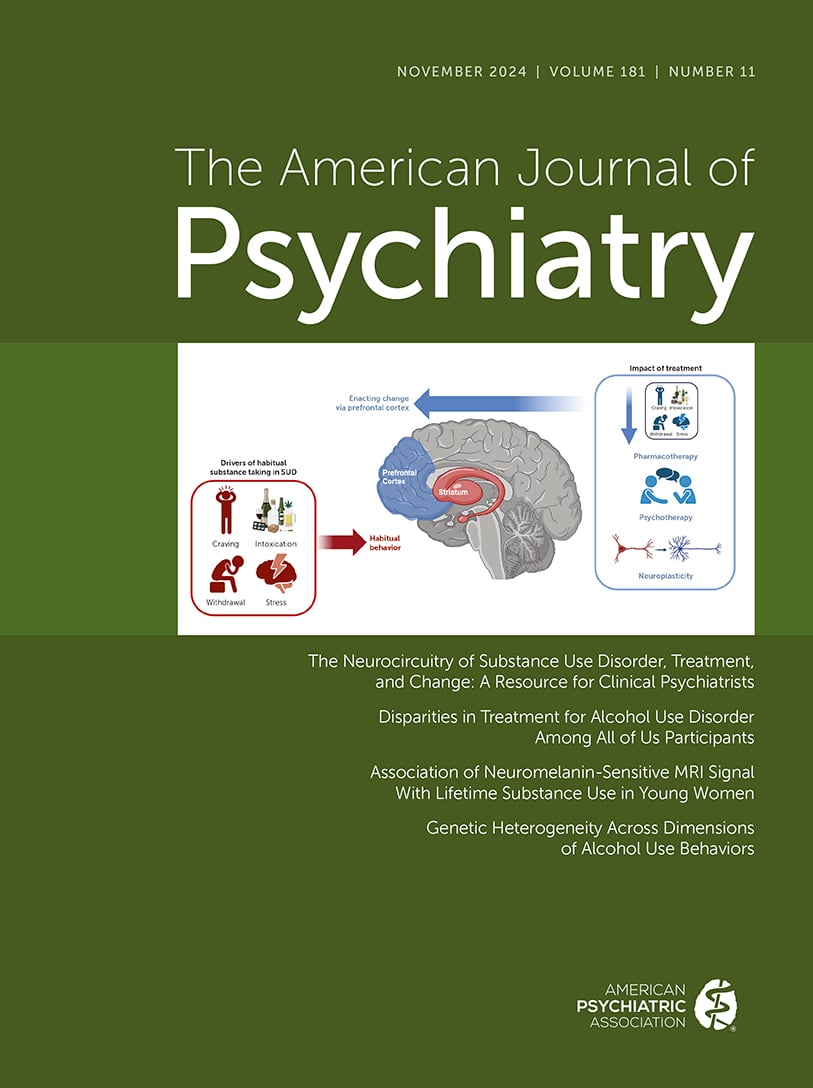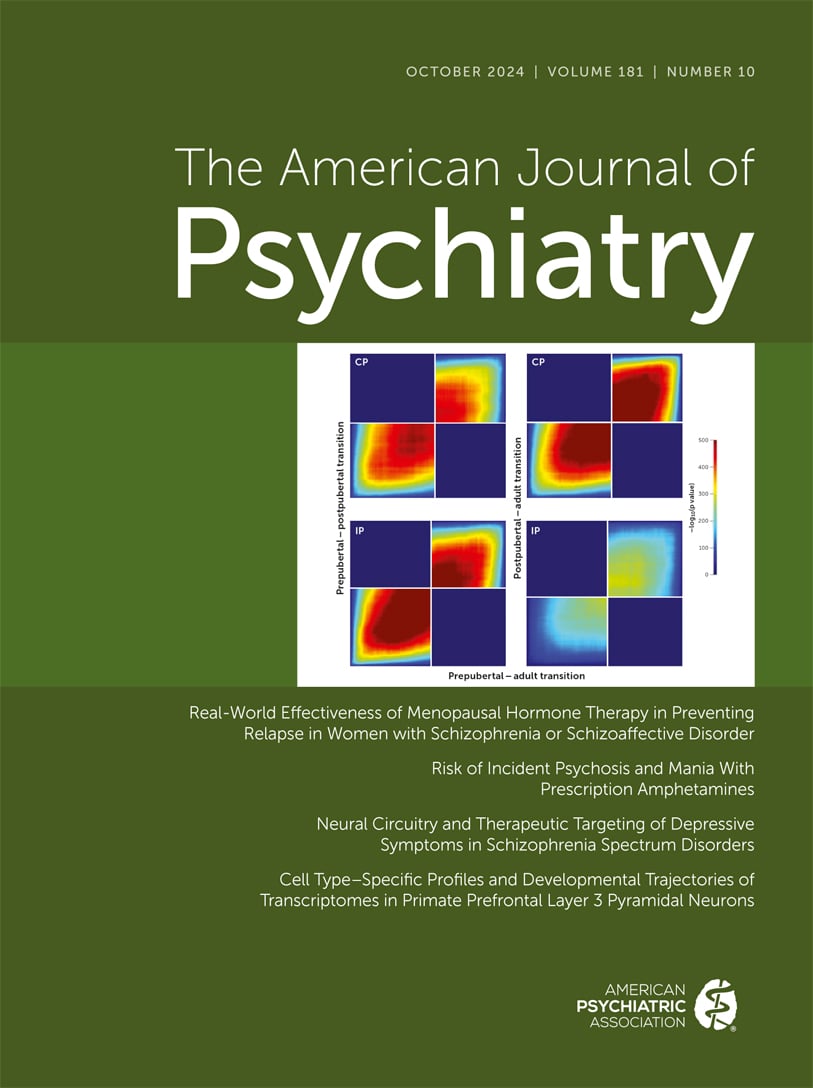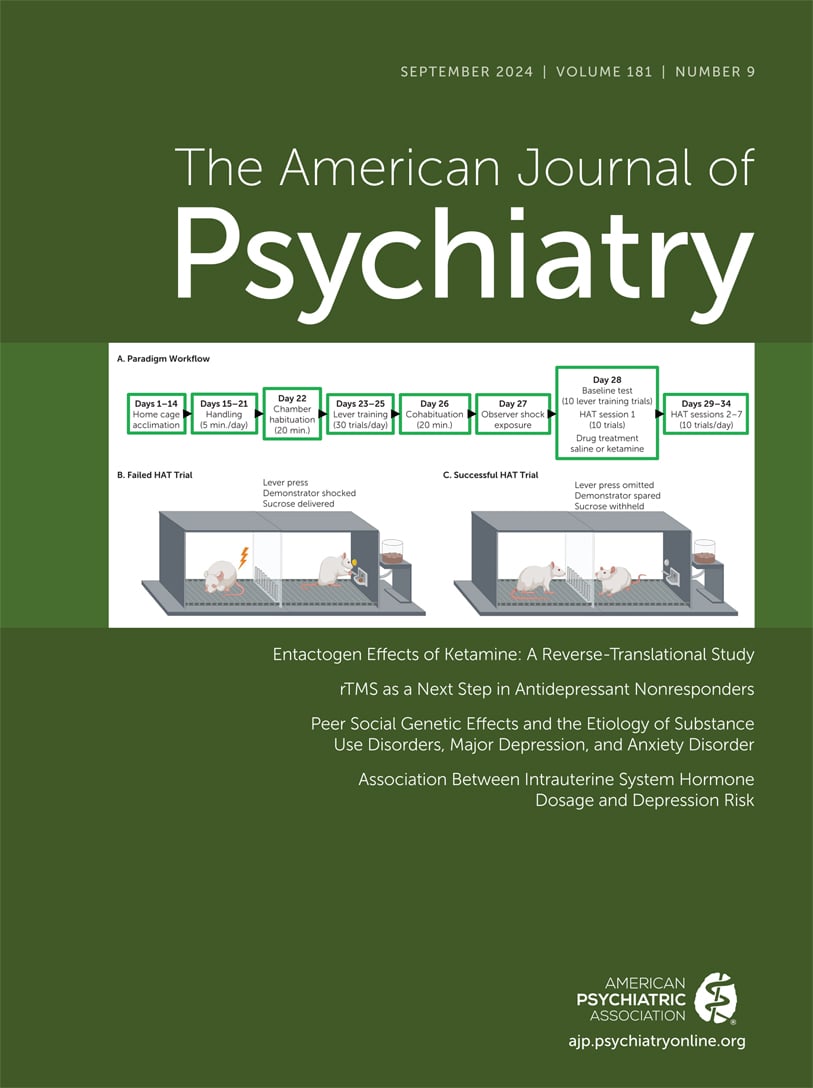American Journal of Psychiatry
- Volume 156
- Number 9
- September 1999
Editorial
Images in Neuroscience
Special Article
Publication date: 01 September 1999
Pages1312–1321OBJECTIVE: The authors examined the evidence for the effectiveness of psychotherapy for personality disorders in psychotherapy outcome studies. METHOD: Fifteen studies were located that reported data on pretreatment-to-postreatment effects and/or recovery ...
https://doi.org/10.1176/ajp.156.9.1312Publication date: 01 September 1999
Pages1322–1327The unprecedented inclusion of culture-bound syndromes in DSM-IV provides the opportunity for highlighting the need to study such syndromes and the occasion for developing a research agenda to study them. The growing ethnic and cultural diversity of the ...
https://doi.org/10.1176/ajp.156.9.1322Regular Article
Publication date: 01 September 1999
Pages1328–1335OBJECTIVE: Subtle behavioral and intellectual abnormalities are often present in apparently healthy adolescents who later develop schizophrenia. The authors investigated whether these abnormalities can predict vulnerability for schizophrenia before the ...
https://doi.org/10.1176/ajp.156.9.1328Publication date: 01 September 1999
Pages1336–1341OBJECTIVE: The primary purpose of this article was to determine if cognitive abilities decline, remain unchanged, or modestly improve throughout the course of schizophrenic illness. METHOD: Forty-two patients with a first hospitalization for ...
https://doi.org/10.1176/ajp.156.9.1336Publication date: 01 September 1999
Pages1342–1348OBJECTIVE: Whether cognitive function in schizophrenia deteriorates, improves, or remains stable is a crucial question. Few studies have examined the longitudinal stability of cognitive function and the relationship between cognitive performance and ...
https://doi.org/10.1176/ajp.156.9.1342Publication date: 01 September 1999
Pages1349–1357OBJECTIVE: The major purposes of this study were 1) to examine whether neurological signs predict cognitive performance in both schizophrenic patients and healthy subjects and 2) to determine the ability of neurological signs and neuropsychological tests ...
https://doi.org/10.1176/ajp.156.9.1349Publication date: 01 September 1999
Pages1358–1366OBJECTIVE: Memory impairment is well documented in schizophrenia. Less is known, however, about the exact magnitude, pattern, and extent of the impairment. The effect of potential moderator variables, such as medication status and duration of illness, is ...
https://doi.org/10.1176/ajp.156.9.1358Publication date: 01 September 1999
Pages1367–1373OBJECTIVE: Patients with schizophrenia consistently show performance deficits on measures of visual backward masking, but the nature of these deficits is not well understood. Performance deficits on backward masking tasks may indicate an underlying ...
https://doi.org/10.1176/ajp.156.9.1367Publication date: 01 September 1999
Pages1374–1379OBJECTIVE: The purpose of this study was to evaluate the clinical safety and efficacy of risperidone compared to haloperidol in patients with treatment-refractory schizophrenia. METHOD: Sixty-seven medication-unresponsive subjects were randomly assigned ...
https://doi.org/10.1176/ajp.156.9.1374Publication date: 01 September 1999
Pages1380–1384OBJECTIVE: The capacities of depressed patients to consent to research have been questioned by commentators who fear that the cognitive effects of a disorder may impair subjects’ abilities to protect their interests. This study used a new instrument for ...
https://doi.org/10.1176/ajp.156.9.1380Publication date: 01 September 1999
Pages1385–1391OBJECTIVE: An influential rationale for involuntary hospitalization is that prospective patients who refuse hospitalization at the time it is offered are likely to change their belief about the necessity of hospitalization after receiving hospital ...
https://doi.org/10.1176/ajp.156.9.1385Publication date: 01 September 1999
Pages1392–1396OBJECTIVE: The goals of this study were to validate a new rating scale for measuring severity of jet lag and to compare the efficacy of contrasting melatonin regimens to alleviate jet lag. METHOD: This was a randomized, double-blind trial of placebo and ...
https://doi.org/10.1176/ajp.156.9.1392Publication date: 01 September 1999
Pages1397–1402OBJECTIVE: The number of U.S. medical graduates choosing careers in psychiatry is in decline. In order to determine whether this disinclination toward psychiatry occurs before versus during medical school, this study surveyed medical students at the start ...
https://doi.org/10.1176/ajp.156.9.1397Publication date: 01 September 1999
Pages1403–1408OBJECTIVE: This study characterizes the responses to placebo medication of patients with premenstrual syndrome (PMS) who were randomly assigned in controlled treatment trials. Possible predictors of placebo response were also examined. METHOD: Subjects ...
https://doi.org/10.1176/ajp.156.9.1403Publication date: 01 September 1999
Pages1409–1416OBJECTIVE: No consistent predictors of outcome have been identified for the pharmacotherapy of obsessive-compulsive disorder (OCD). Recent factor analytic studies have identified meaningful symptom dimensions that may be related to response to serotonin ...
https://doi.org/10.1176/ajp.156.9.1409Publication date: 01 September 1999
Pages1417–1420OBJECTIVE: Disturbance in glucose homeostasis in psychiatric populations has been suggested since the early part of this century. Increased comorbidity of diabetes mellitus in persons with major mood disorders has also been suggested. The goal of this ...
https://doi.org/10.1176/ajp.156.9.1417Publication date: 01 September 1999
Pages1421–1424OBJECTIVE: This study tested the reliability and validity of four definitions of rapid cycling. METHOD: Two trained psychiatrists, using the Schedule for Affective Disorders and Schizophrenia, independently assessed 210 patients with bipolar disorder. ...
https://doi.org/10.1176/ajp.156.9.1421Publication date: 01 September 1999
Pages1425–1431OBJECTIVE: The purpose of this study was to compare the clinical and demographic profiles of patients who deliberately harmed themselves, either by jumping from a great height or by using firearms, and survived. METHOD: The study consisted of an 18-year ...
https://doi.org/10.1176/ajp.156.9.1425Clinical Case Conference
Images in Psychiatry
Brief Report
Publication date: 01 September 1999
Pages1440–1443OBJECTIVE: This study assessed whether brain dopamine D2 receptor levels, which show significant intersubject variability, predict reinforcing responses to psychostimulants in humans. METHOD: [11C]Raclopride and positron emission tomography were used to ...
https://doi.org/10.1176/ajp.156.9.1440Publication date: 01 September 1999
Pages1444–1446OBJECTIVE: During early abstinence, many cocaine-dependent individuals experience symptoms such as anhedonia, craving, fatigue, insomnia, and dysphoria. While several studies have shown an association between depressive symptoms and negative treatment ...
https://doi.org/10.1176/ajp.156.9.1444Publication date: 01 September 1999
Pages1447–1449OBJECTIVE: In humans, interindividual variation in sensitivity to benzodiazepine drugs may correlate with behavioral variation, including vulnerability to disease states such as alcoholism. In the rat, variation in alcohol and benzodiazepine sensitivity ...
https://doi.org/10.1176/ajp.156.9.1447Publication date: 01 September 1999
Pages1450–1452OBJECTIVE: A functional polymorphism in the transcriptional control region upstream of the coding sequence of the 5-hydroxytryptamine transporter (5-HTT) has been reported. This polymorphism has been shown to influence the antidepressant response to ...
https://doi.org/10.1176/ajp.156.9.1450Publication date: 01 September 1999
Pages1453–1455OBJECTIVE: An association between the type 4 dopamine receptor (DRD4) gene and the behavioral trait of novelty seeking has been reported, but several studies have failed to replicate this finding. In the present study, the authors tested for this ...
https://doi.org/10.1176/ajp.156.9.1453Publication date: 01 September 1999
Pages1456–1458OBJECTIVE: Postmortem studies have indicated that suicide victims have greater serotonin receptor 2A (5-HTR2A) binding in prefrontal brain regions. However, there remains some controversy regarding the biological specificity of these findings. The authors ...
https://doi.org/10.1176/ajp.156.9.1456Book Forum: SOMATIC TREATMENTS AND THEIR EVALUATION
Book Forum: PSYCHOANALYSIS/PSYCHOTHERAPY
Book Forum: ALCOHOLISM
Book Forum: CHILD PSYCHIATRY
Book Forum: ADHD
Book Forum: SEXUALITY
Letter to the Editor
Past Issues
View Issues Archive
Vol. 181 | No. 12

Vol. 181 | No. 11

Vol. 181 | No. 10
